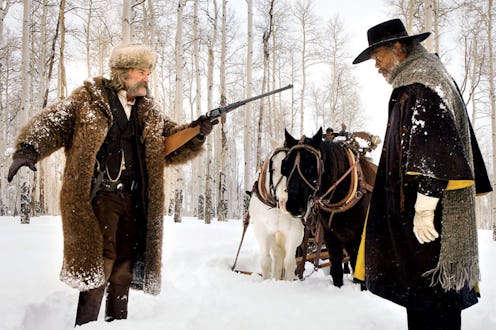
The Hateful Eight isn't just another blood-soaked drama unfit for the squeamish. It's the Quentin Tarantino movie that almost wasn't. After a near-disastrous script leak in 2014, the director announced that he was canceling the development of The Hateful Eight, an ensemble Western and his follow-up to Django Unchained. But something in the project drove Tarantino to move past the setback and forward with production. Fortunately for the controversial filmmaker's fans, he couldn't put the story down. And regardless of its historic setting, The Hateful Eight isn't a true story, but an original one.
The Hateful Eight follows a group of travelers including a bounty hunter (Kurt Russell) and his prize (Jennifer Jason Leigh) into a stagecoach lodge called Minnie's Haberdashery to wait out a blizzard. That lodge becomes a pressure cooker for eventual vengeance and violence, with almost every traveler and drinker seeking some kind of retribution. The film is set on the western frontier (Wyoming, to be specific) in the 1870s, just a few years after the end of the Civil War. That's an important point. Warren, another bounty hunter played by Samuel L. Jackson, proudly shows off a treasure to his travel companions: a letter to him from Abraham Lincoln. Bruce Dern's character Sanford Smithers is a veteran Confederate general who they meet in the lodge — still viciously racist. In the character notes he provided to the Los Angeles Times, Tarantino describes Smithers as "a legendary Southern combat general, with a very bloody past and a possibly bloodier future."
Smithers is not based on a real life Confederate general, at least in any direct way. And the rest of the characters are just as fictional. But its setting, timeline, and theme of racial discord does hint at The Hateful Eight's origins in another Tarantino project. In an interview with DP/30, the director reveals that The Hateful Eight was originally conceived as a sequel to Django Unchained. In fact, it wasn't even originally intended for the screen. Tarantino was considering publishing a Django continuation novel. But at a certain point, the narrative fell apart. Tarantino explains...
I realized, because I was introducing such rough characters in this piece, and there would be even more rough, disreputable characters waiting for them at Minnie's...Well, you know what’s wrong with this piece? It’s Django...No, I shouldn't have a moral center. There shouldn't be a hero. Everybody should be questionable.
The Hateful Eight — like every movie made by Quentin Tarantino, the ultimate movie fan — is more of a course in film history than human history. Its distributor, The Weinstein Company, leaned into the the movie's gun-slinging, screen cowboy history by funding a Hateful Eight Roadshow tour. Audiences could see the film in 70mm, the format popular when spaghetti westerns ruled, with an extended overture and full intermission. The music itself is another nod to the genre's legacy; The Hateful Eight is scored by Ennio Morricone, best known for his collaborations with director Sergio Leone and especially the instantly identifiable theme to The Good, The Bad, And The Ugly.
You won't find the story of The Hateful Eight in any history book. But as usual, filmmaker Quentin Taratino uses his own original work to pay homage to popular culture.
Images: The Weinstein Company; Giphy